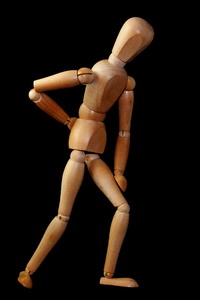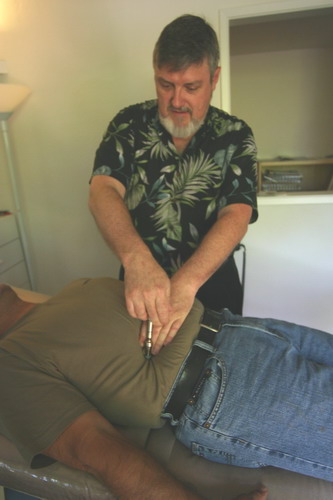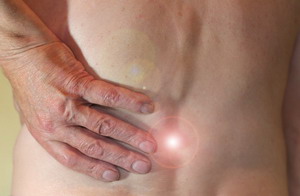Categories
 How many times each day do I work on someone’s low back problem? This is the most common reason folks come into my office for care. The thing is, often times the real problem is not the low back at all. The pain is in the low back, but the cause may be further forward in the colon. The ileocecal valve or ICV is a muscular sphincter where the small intestine joins into the colon. Its purpose is to control how fast digested food and liquid enters the colon and to prevent the high concentrations of bacteria from the colon from entering into the small intestine. When the valve is stuck open, too much liquid can enter the colon and you end up with diarrhea. Likewise, when it is stuck open, bad bacteria can back up into the small intestine giving you a condition called SIBO – Small Intestinal Bacteria Overgrowth.
How many times each day do I work on someone’s low back problem? This is the most common reason folks come into my office for care. The thing is, often times the real problem is not the low back at all. The pain is in the low back, but the cause may be further forward in the colon. The ileocecal valve or ICV is a muscular sphincter where the small intestine joins into the colon. Its purpose is to control how fast digested food and liquid enters the colon and to prevent the high concentrations of bacteria from the colon from entering into the small intestine. When the valve is stuck open, too much liquid can enter the colon and you end up with diarrhea. Likewise, when it is stuck open, bad bacteria can back up into the small intestine giving you a condition called SIBO – Small Intestinal Bacteria Overgrowth. How does this relate to low back pain? Well, what causes this valve to stick open is some sort of inflammatory process triggered by poor circulation, much the same as poor circulation into your shoulder muscles will cause them to spasm and get inflamed. When this valve spasms and gets inflamed, it sends pain signals into the spine where something called a viscero-somatic reflex occurs. The pain signal sends a message to the big movement muscles in the area to also go into spasm. The muscles in that area are the low back muscles – the psoas, which go from the front of the spine to the groin, and the quadratus lumborum, which goes from the spine to the crest of the hip. Any of you that have had low back pain are well familiar with these muscles.
How does this relate to low back pain? Well, what causes this valve to stick open is some sort of inflammatory process triggered by poor circulation, much the same as poor circulation into your shoulder muscles will cause them to spasm and get inflamed. When this valve spasms and gets inflamed, it sends pain signals into the spine where something called a viscero-somatic reflex occurs. The pain signal sends a message to the big movement muscles in the area to also go into spasm. The muscles in that area are the low back muscles – the psoas, which go from the front of the spine to the groin, and the quadratus lumborum, which goes from the spine to the crest of the hip. Any of you that have had low back pain are well familiar with these muscles. This valve can also spasm closed, which diminishes liquid flow into the colon and in turn, produces constipation. Either spasm can trigger low back pain, but the associated gut symptoms will be different. If you have wondered why I ask about any gut issues you might have when you come in with low back pain, this is why.
This valve can also spasm closed, which diminishes liquid flow into the colon and in turn, produces constipation. Either spasm can trigger low back pain, but the associated gut symptoms will be different. If you have wondered why I ask about any gut issues you might have when you come in with low back pain, this is why. In either case, spasm open or closed, a condition that in the old days was called auto-toxemia can occur. This means just what it sounds like – you poison yourself with toxins in the gut backing-up into the small intestine where they can be absorbed into the bloodstream. This can create a host of problems elsewhere in the body, such as:
In either case, spasm open or closed, a condition that in the old days was called auto-toxemia can occur. This means just what it sounds like – you poison yourself with toxins in the gut backing-up into the small intestine where they can be absorbed into the bloodstream. This can create a host of problems elsewhere in the body, such as: As you can see, this condition is not to be taken lightly. So what causes this trouble with the valve into the colon? I find that three situations seem to be the culprits most of the time. First is eating scratchy foods like seeds, popcorn, and raw veggies that have not been well chewed; stuff like that. I tell people that have an ICV problem “If you would not want to rub that food on your eye, then don’t put it in your mouth.” The tissues of the small intestine are sensitive to anything that is rough and scratchy. It secretes a thick mucus to help things slide along, but sharp pokey edges can damage it. So, any crunchy food must be well-chewed to eliminate those pokey edges.
As you can see, this condition is not to be taken lightly. So what causes this trouble with the valve into the colon? I find that three situations seem to be the culprits most of the time. First is eating scratchy foods like seeds, popcorn, and raw veggies that have not been well chewed; stuff like that. I tell people that have an ICV problem “If you would not want to rub that food on your eye, then don’t put it in your mouth.” The tissues of the small intestine are sensitive to anything that is rough and scratchy. It secretes a thick mucus to help things slide along, but sharp pokey edges can damage it. So, any crunchy food must be well-chewed to eliminate those pokey edges. The second cause of ICV spasms is stress. The proper action of this valve is controlled by the Vagus nerve. I have written about this nerve before as the main nerve associated with the stress response. It controls our heart rate, breathing rate, and digestion – including the tone of the ileocecal valve. The balance between this nerve and the fight or flight hormone, adrenaline, creates how we feel moment to moment. Stress on the body happens when there is too much adrenaline and not enough messaging from the Vagus nerve. Emotional stress not only affects the Vagus nerve, but also triggers the release of an inflammatory chemical called interleukin 6, the same chemical that we release when we get the flu.
The second cause of ICV spasms is stress. The proper action of this valve is controlled by the Vagus nerve. I have written about this nerve before as the main nerve associated with the stress response. It controls our heart rate, breathing rate, and digestion – including the tone of the ileocecal valve. The balance between this nerve and the fight or flight hormone, adrenaline, creates how we feel moment to moment. Stress on the body happens when there is too much adrenaline and not enough messaging from the Vagus nerve. Emotional stress not only affects the Vagus nerve, but also triggers the release of an inflammatory chemical called interleukin 6, the same chemical that we release when we get the flu. The third cause of ileocecal valve spasms is some sort of infection – bacterial, viral, parasitic, or fungal. This especially comes into play with the SIBO condition I mentioned earlier. This becomes a self-creating condition, because once the valve spasms, SIBO occurs and creates the infection that generates more spasm by backing bad gut critters up into the small intestine. In these cases, we have to make some pretty radical diet changes to stop feeding the bad gut bugs and stop creating inflammation.
The third cause of ileocecal valve spasms is some sort of infection – bacterial, viral, parasitic, or fungal. This especially comes into play with the SIBO condition I mentioned earlier. This becomes a self-creating condition, because once the valve spasms, SIBO occurs and creates the infection that generates more spasm by backing bad gut critters up into the small intestine. In these cases, we have to make some pretty radical diet changes to stop feeding the bad gut bugs and stop creating inflammation. In the office, I address the ileocecal valve spasm with an adjustment right on the valve to release the spasm. You can’t do this at home because you have to be able to test or feel which direction the adjustment has to be made. However, there is a way you can, at home, treat an ileocecal valve spasm through the use of a Bennett Neurovascular Reflex. Dr. Bennett, a chiropractor, discovered contact points in various places on the body that, when held lightly, would increase the blood flow around various organs. Since the basic cause of the ileocecal valve spasm is a decrease in the blood flow around the valve, holding this reflex point for a few minutes can re-set and relax the spasm in the valve. If the problem has not progressed to the infection phase, most of the time using the Bennett reflex will release the spasm and allow the gut to settle down. However, if you keep eating scratchy foods, stay stressed, or have an infection, then further work will have to be done.
In the office, I address the ileocecal valve spasm with an adjustment right on the valve to release the spasm. You can’t do this at home because you have to be able to test or feel which direction the adjustment has to be made. However, there is a way you can, at home, treat an ileocecal valve spasm through the use of a Bennett Neurovascular Reflex. Dr. Bennett, a chiropractor, discovered contact points in various places on the body that, when held lightly, would increase the blood flow around various organs. Since the basic cause of the ileocecal valve spasm is a decrease in the blood flow around the valve, holding this reflex point for a few minutes can re-set and relax the spasm in the valve. If the problem has not progressed to the infection phase, most of the time using the Bennett reflex will release the spasm and allow the gut to settle down. However, if you keep eating scratchy foods, stay stressed, or have an infection, then further work will have to be done. Here is a picture of an abdomen. To find the Bennet reflex point for the ICV, draw an imaginary line from the belly button down to the top of the right crest of the pelvic hip bone. In the picture, this is the blue line. Now go one half of the way down that line to the middle, where the red X is, and this is the reflex point. The technique is to lightly hold this point for about 5 minutes. The power of this technique is amplified if you also stretch any long muscle with your other hand and hold this stretch. I like to grab my hamstrings on the left with my left hand and just pull on them a bit while I hold the ICV reflex point with my right hand. With practice, you may find that you can feel the pulsation of the blood vessels in the skin under your treating fingers. You want to feel for a strengthening and a regularity of this pulse to tell you the treatment is progressing well.
Here is a picture of an abdomen. To find the Bennet reflex point for the ICV, draw an imaginary line from the belly button down to the top of the right crest of the pelvic hip bone. In the picture, this is the blue line. Now go one half of the way down that line to the middle, where the red X is, and this is the reflex point. The technique is to lightly hold this point for about 5 minutes. The power of this technique is amplified if you also stretch any long muscle with your other hand and hold this stretch. I like to grab my hamstrings on the left with my left hand and just pull on them a bit while I hold the ICV reflex point with my right hand. With practice, you may find that you can feel the pulsation of the blood vessels in the skin under your treating fingers. You want to feel for a strengthening and a regularity of this pulse to tell you the treatment is progressing well. Use this technique any time you have either constipation or diarrhea. Also to bring things full circle, use this technique if your low back is acting up for no reason on the right side. If there has been no lifting injury or fall, then chances are that the IC valve may be sending pain signals into the spine at that level and causing the low back muscles on the right to also spasm, causing your pain. This same muscle reaction pattern also happens when you have a kidney stone, only the pain is much worse.
Use this technique any time you have either constipation or diarrhea. Also to bring things full circle, use this technique if your low back is acting up for no reason on the right side. If there has been no lifting injury or fall, then chances are that the IC valve may be sending pain signals into the spine at that level and causing the low back muscles on the right to also spasm, causing your pain. This same muscle reaction pattern also happens when you have a kidney stone, only the pain is much worse. I have had patients with chronic diarrhea for weeks find that within hours of this adjustment everything settles down. Likewise, folks that have had their bowels locked up have gotten things moving within hours. There can be a lot of other things going on that may be the source of grief in this area, but this is a really common issue and one that is easily solved without ever having to go see a doctor. Just another little self-help tool to reduce the challenges in life.
I have had patients with chronic diarrhea for weeks find that within hours of this adjustment everything settles down. Likewise, folks that have had their bowels locked up have gotten things moving within hours. There can be a lot of other things going on that may be the source of grief in this area, but this is a really common issue and one that is easily solved without ever having to go see a doctor. Just another little self-help tool to reduce the challenges in life.